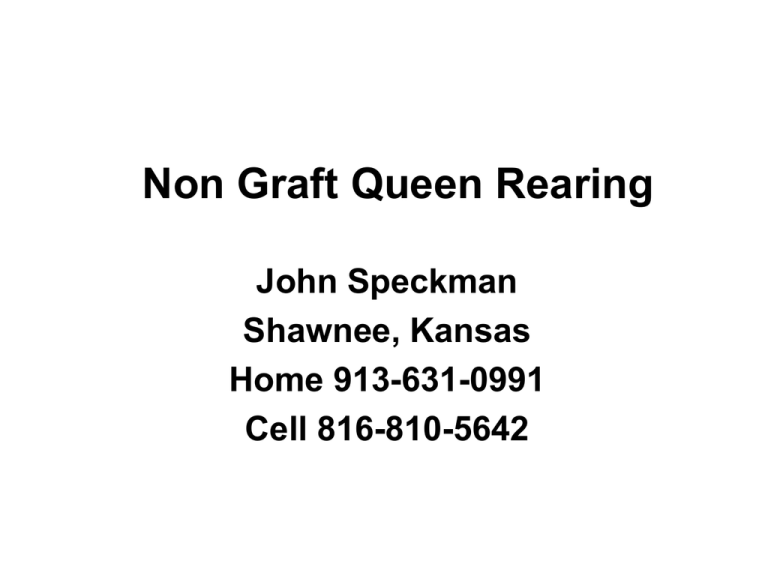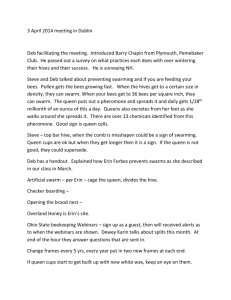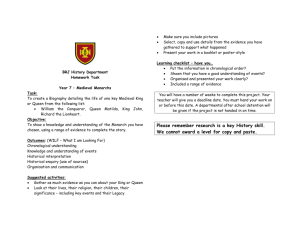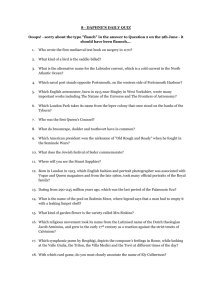Raising Queens Using
advertisement

Non Graft Queen Rearing John Speckman Shawnee, Kansas Home 913-631-0991 Cell 816-810-5642 Raising Queens Using the Jenter System Why raise your own Queens • Cost – Typical cost is around $20.00 - $25.00 • Advantage - Have extra queens avail if needed • Proved Stock -Raise from you own “Good” producing colonies. • Mite and disease resistance • Quality Bees rear queens because of one of the following conditions Emergency. Supersedure. Swarming We get the most cells and the best feeding for the queens if we simulate both Emergency and Overcrowding. Jenter Queen Kit The Jenter Method of Queen Production • This system is used to produce young larvae to be subsequently transferred to the cell starter. • Equipment Needed: The complete Jenter queen rearing kit drawn brood frame or medium depth frame. • Pre-Requisites: Breeder queen Cell starter colony / cell finisher colony Mating nuc. Step 1 Prepare Cell Frame Insert all the cell plugs into the Confined Queen Lay area of Frame Step 2 – Prepare cell frame (2) Days prior to confinement of queen in Jenter frame •Insert frame in colony so bees can polish cells Remove the complete cover so bees can access cells to clean up. Beekeeping Calendar Example • Queen Rearing Calendar for 1/10/2015 Brought to you by “The Beekeepers of the Susquehanna Valley” www.thebeeyard.org Day # 1 2 3 4 5 DOW Wednesday Thursday Friday Saturday Sunday Date 1/7 1/8 1/9 1/10 1/11 6 7 8 9 10 11 12 13 14 15 16 17 18 19 20 21 22 23 24 25 26 27 28 29 30 31 32 33 34 35 36 37 38 39 40 Monday Tuesday Wednesday Thursday Friday Saturday Sunday Monday Tuesday Wednesday Thursday Friday Saturday Sunday Monday Tuesday Wednesday Thursday Friday Saturday Sunday Monday Tuesday Wednesday Thursday Friday Saturday Sunday Monday Tuesday Wednesday Thursday Friday Saturday Sunday 1/12 1/13 1/14 1/15 1/16 1/17 1/18 1/19 1/20 1/21 1/22 1/23 1/24 1/25 1/26 1/27 1/28 1/29 1/30 1/31 2/1 2/2 2/3 2/4 2/5 2/6 2/7 2/8 2/9 2/10 2/11 2/12 2/13 2/14 2/15 Task/Status Notes The egg is laid by the queen mother Select or create a queenless cell builder colony Graft the day-old larvae into cell cups, and insert into a queenless cell builder colony. Check your grafts: the bees should have started to draw out the cells and feed the larvae with royal jelly. If not, re-graft. Queen cells are capped Sensitive developmental phase - do not move cells and be very gentle when opening the hive. Move the capped queen cells into mating nucs Queens hatch Discard any unhatched cells Mating Flights Check Nuc for eggs. Check Nuc for larvae. Larvae found? If so, the queen is ready! Re-queen if no eggs are present. Step 3 – Cage queen in frame Day (0) Catch queen, and place in enclosed cell frame, make sure cover is on tight, and the queen excluder plug is in place. Caged queen should lay out enclosed cells in 24 hrs, this is important , so will you know the age of larvae to be grafted. Step 4 – Release queen Day (1) Day (1) for counting days till hatch (16) days You now want to remove cover of enclosed cell unit and let queen and attendants rejoin colony. Step 5 – Prepare cell bars 1. Coat cell bars with thin layer of beeswax 2. Push cell base into the warm beeswax 3. Add a additional coat of beeswax around the cell base. This will insure a good solid seal to cell bar. Step 6 – Make Up Cell Starter/Finisher colony (Day 3) • Shake or Brush bees from donor colonies. Try and use bees from frames of eggs/larvae (Nurse Bees) • Frames of Honey & Pollen NO frames with eggs or larva. NO queen. • We add a feeder of syrup to the starter colony to make sure they are well fed. • We usually place this colony inside in a dark area, using screen on bottom & top, this helps to keep the bees calm prior to inserting the cells Step 7 – Day 4 (Transfer larvae to Cell Cups) • You can leave your starter box open to allow bees to fly free, • or you can contain bees using a double screen on bottom and top, and place inside in a dark room. • We have started to confine the bees for the first 24-36 hours, this has really helped the first several grafts, as the weather in early April can be unpredictable. Step – Day 5/6 Check on cells After the first 24-36 hours,,, the nurse bees will be busy feeding the young larvae We have used the cell starter as the finisher colony also, which has worked well for us. An option would be to create a cell starter and a finisher colony. Day 12- Make Up Nuc’s • • • • 2- frames brood Pollen/nectar Feed???? Spray bees with sugar syrup to keep from flying. Baby Mating Nuc Box 2-way Med Super Nuc Box Deep Nuc – 2way split Day 13 – Pull/Set Cells in nuc’s • Must pull cells on time no matter what • Keep in mind .. The 13th day is very critical to pull cells and place in nuc. • If a queen hatches early… she will destroy any remaining cells. • Check the cells prior to placing in nucs • An addition to the Jenter system, is a clear plastic tube, which fits over the sealed queen cell to allow the queen to hatch in the tube. • This eliminates the issue of a queen hatching early and destroying unhatched queen cells. Missed cell / early hatch results Comments on Nucs • Make sure to provide feed if needed • Do NOT Disturb bees • Could be confined in dark room for 24-72 hrs after inserting cell. Day 28 1St Inspection • Look for laying queen in nucs • Can cage for install into other hive or leave for 14 days to insure pattern of brood. • Congratulations you have raised your 1st batch of queens References • http://www.thebeeyard.org/queenrearing-calendar/ Blue Sky Beekeeping Supply— www.blueskybeesupply.com






